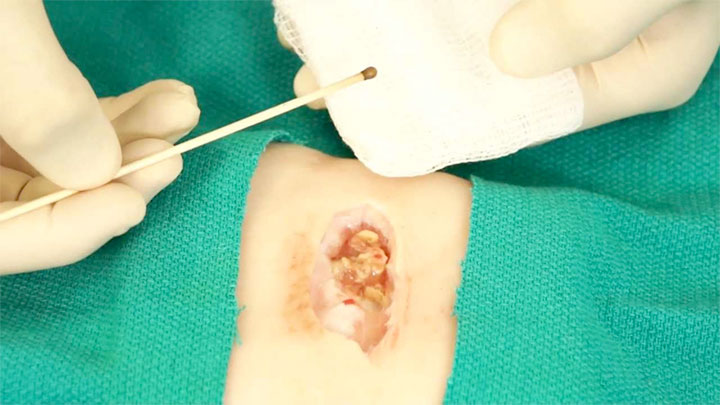Topical application of silver nitrate is often used in wound care to help remove and debride hypergranulation tissue or calloused rolled edges in wounds or ulcerations. It’s also an effective agent to cauterize bleeding in wounds. Silver nitrate is a highly caustic material, so it must be used with caution to prevent damage to healthy tissues.
Application method
Silver nitrate applicators are firm wooden sticks with 75% silver nitrate and 25% potassium nitrate embedded on the tip. Moistening the tip sparks a chemical reaction that burns organic matter (skin), coagulates tissue, and destroys bacteria.
Related Articles
Critical care of the skin – Pressure injury (PI) care bundles help to reduce variations in care and improve outcomes….
Transitioning wound care patients to post-acute care – When discharging a patient who needs wound care, acute-care clinicians (wound care nurse, discharging nurse, and case manager) should…
Wound dehiscence – Dehiscence of abdominal surgical wounds is a medical emergency and requires immediate action to reduce…
Precautions
• Silver nitrate is very caustic to skin and clothing. Wear protective equipment as needed.
• Excess silver nitrate can be neutralized with 0.9% or stronger saline and then washed away with water.
• Because silver nitrate is a corrosive substance, apply it only to tissue to be treated. Take care to confine the silver nitrate to the desired area by using a suitable barrier, such as petroleum jelly. Prevent any excess from oozing by covering the application area as necessary.
• Silver nitrate directly reduces fibroblast proliferation, so it is not recommended for prolonged or excessive use.
• Some patients report pain or burning during treatment with silver nitrate. Consider the need for medication before the procedure, including use of topical anesthetic, to reduce discomfort.
Procedure
1. Wash your hands and put on gloves.
2. Remove the wound dressing, following dressing-removal procedure.
3. Wash your hands and put on new gloves.
4. Clean the wound with sterile normal saline solution according to wound cleansing procedure.
5. Remove your gloves, wash your hands, and put on new gloves.
6. Confine the area to be treated by encircling it with petroleum jelly or equivalent.
7. Cover the wound base tissue with moistened normal saline gauze to protect it from any spillage. It is important not to allow drips of silver nitrate to settle on any surface, as they will stain and burn.
8. Slightly moisten the caustic tip of the silver nitrate applicator stick by dipping (tip only) in distilled or deionized water.
9. To apply to tissue, rub and rotate the tip of the applicator along the tissue to be debrided. Two minutes of contact time is typically sufficient, keeping in mind that the degree of caustic action depends on the quantity of silver nitrate applied, which in turn is governed by the length of time the moistened tip is left in contact with the tissue. Do not touch any other part of the body, clothing, or furnishings with the tip. Depending on the size of the area to be debrided, more than one applicator may be needed.
10.Monitor the patient closely for response to the procedure, including pain and discomfort. STOP the procedure if the patient complains of pain.
11. Use damp saline gauze to gently clean the treated area after application. Pat dry to avoid trauma to surrounding tissue. Do not rub or apply friction to treated area.
12. Remove gloves and put on new ones.
13. Apply any other prescribed treatment to the wound base as ordered.
Length of treatment
Frequency of application varies based on wound needs. If silver nitrate is being used for hypergranulation, apply it once daily for up to 5 days or until resolution of hypergranulation. In the case of rolled edges/epibole, treatment varies from daily to 3 times a week until the problem is resolved.
Use with care
Silver nitrate can be an effective tool in treating wounds, but, as with many treatments, it must be used with care to obtain the best results for patients. ?
Nancy Morgan, cofounder of the Wound Care Education Institute, combines her expertise as a Certified Wound Care Nurse with an extensive background in wound care education and program development as a nurse entrepreneur.
Selected references
Crawley-Coha T. A practical guide for the management of pediatric gastrostomy tubes based on 14 years of experience. J Wound Ostomy Continence Nurs. 2004;31(4):193-200.
Garten AJ. Keys to diagnosing and addressing hypergranulation tissue. Podiatry Today Blog. 2015.
Stephen-Haynes J, Hampton S. Achieving effective outcomes in patients with over-granulation. Wound Care Alliance UK. 2010.








